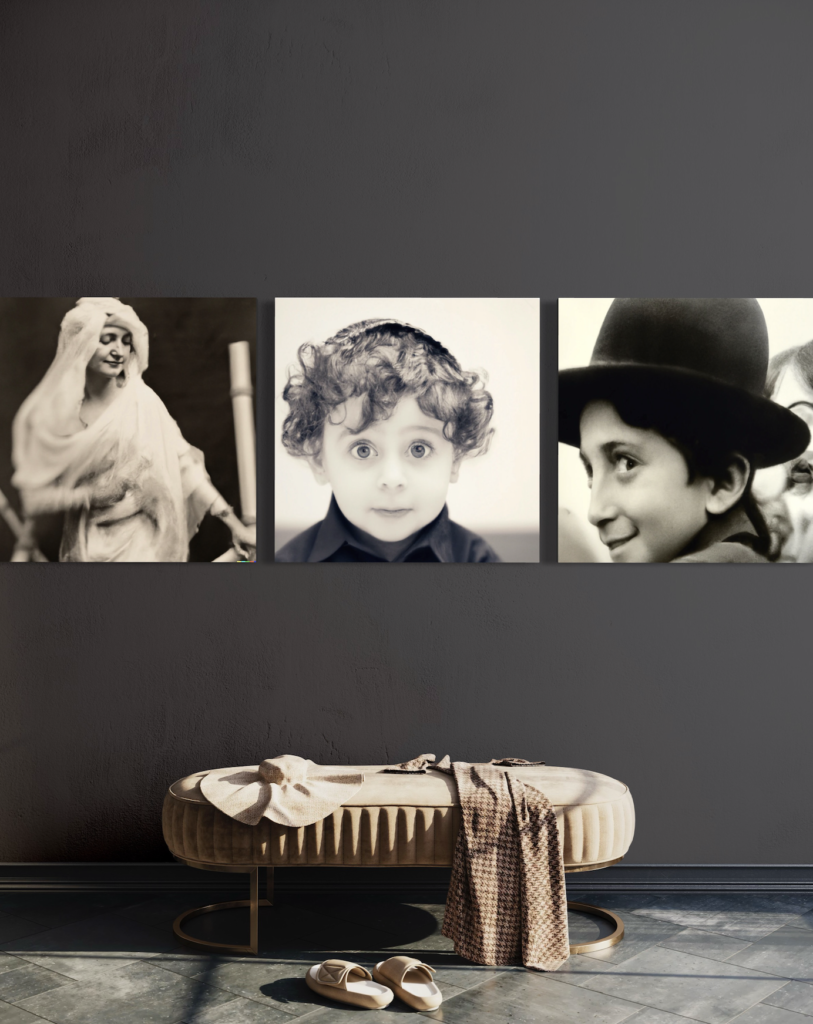
Moving from left to right:
Paulina Secklowicz.
Mendel Markovitz.
Shmuel Hersh.
I am creating stories for all of these people. Although they are images I created in collaboration with DALL’E 2, they are becoming real to me. I am imagining back stories and future stories and lives.
Paulina Secklowicz. She is shown on her wedding day, in February 1911. She is the daughter of the tailor, Benjamin Secklowicz. Her gown is made of fabric that has come all the way from France. She and her new husband, Perchik Kaplansky (later Peter Kaplan) left the shtetl of Liuh in 1913, just before the outbreak of WWI and only a few years prior to the Russian Revolution. They settled first in Brooklyn and then moved to Scarsdale, New York. They had one child, a son named David. Paulina died at age 46, still a beauty, but riddled with cancer. David, who would be known professionally as David Kaye, became a successful Hollywood film director but was forever haunted by the memory of his beautiful mother. He never married. Paulina’s only child died in 1987, after suffering a heart attack by his swimming pool.
Mendel Markovitz. The sweetest child probably ever seen in Liuh. His parents, Lazar and Blooma, did not leave Liuh. They sent Mendel to America for opportunities and promised they would “come soon.” By the time Lazar and Blooma were ready, it was far too late. The Germans entered Liuh in 1942. They locked the few remaining Jews, including Lazar and Blooma Markovitz, in a barn and lit a match. Lazar and Blooma were spared the knowledge that Mendel would be killed in a hit and run accident in Philadelphia just two days shy of his fifty-third birthday. He had made it to America, married a lovely woman named Alice, had twin daughters, and was the proud owner of a Chevy dealership. He was a nervous man and suffered from anxiety and ulcers. Mendel was president of his synagogue.
And Shmuel. Shmuel Hersh moved to America in 1911. Same year as my grandmother. He traveled with his mother. His father met them in NYC, in the New World, and they lived on Clinton Street in the Lower East Side. Shmuel, by then Sam, ended up as a top carpet salesman for Macy’s, before opening a successful Jewish summer camp in the Catskills. Sam was the life of every party. He could tell a joke like nobody’s business. Sam Hersh lived to see 90 years of age. He had 17 grandchildren and 8 great-grandsons at the time of his death.
None of this is true. And none of it is untrue, either. I’m making up the stories. Some get great endings — loads of family and friends, long lives, successful businesses, condos in Boca — and other get lousy endings. Some get tragic endings, too, and that hurts me.
With a project like this (“The Last Jews of Liuh”), I cannot keep real distance. I need these people to be real to me and to have real lives. In return, I need to be respectful of what the cards might deal. I am determined to avoid caricature.
My dream is to see my Liuh people in very large and very beautiful prints like this. Hanging together — all sixty of them! Remembered, honored, seen for who they were: people. Not statistics, not caricatures. Not uniformly tragic. Not unrealistically upbeat. Keepers of some version of the American dream.
Sometimes, I admit, my people haunt my dreams. I grieve Mendel. I feel such empathy and sadness for Paulina, who feared losing her beauty more than she feared losing her life. And I smile at the mischievous Sam and all of those great grandsons.
I believe this is what it means to be in my work.
Their stories are as fascinating as their photos.
Thank you xx
just incredible.. i am taken with their stories.. i’m drawn into their world.. their lives.. there is way more here… keep going!!
Thank you xxx
I also create stories about people I meet. None as vivid as these. I was completely drawn in.
Thank you so much, Darcy. Nothing is more fascinating, imho, than peoples’ stories. x
lovely stories and the images are stunning…
Thank you, my friend. We have our stories, right? xx